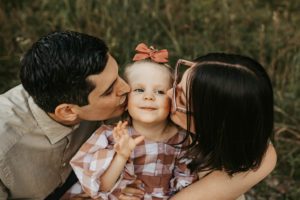“Together, we can do hard things.” That’s the mission of Clara Inspired, a nonprofit organization that aims to raise awareness and funds to cure genetic disorders like STXBP1 disorders. It’s also a mission that consistently inspires and motivates gallerist Bridget Finn, whose own daughter Florence was diagnosed with STXBP1 in 2021. Receiving a rare disease diagnosis is hard. Trying to understand the progression of a rare disease is hard. Working towards a treatment and a cure – also hard. Yet Bridget, with the support of her community and a deep love for her child, knows that she can get through any hard situation if it means that she can make a change for Flo.

On September 29, 2022, Bridget partnered with Christie’s New York to present FLOURISH: Art for the Future – Supporting a Cure for STXBP1 Disorders. During this event, artwork donated by artists such as KAWS, Derek Fordjour, Sam Moyer, Eddie Martinez, and more was sold to raise funds for STXBP1 research. Through this, Bridget hopes to add to the great efforts made by fellow parents and researchers to find a cure and eradicate STXBP1.
Recently, Bridget and I sat down to discuss STXBP1 and Flo’s story, how FLOURISH is working as a multifaceted fundraising endeavor, and advice for other families going through this journey so that they know that they are not alone.
To learn more about FLOURISH and how you can contribute to this cause, head to the FLOURISH website.
What is STXBP1?
The STXBP1 Foundation explains that the STXBP1 gene, located on chromosome 9q34.1, was first discovered in 2008 in patients with a severe form of early-onset epilepsy called Ohtahara Syndrome. Since then, researchers have determined that STXBP1 mutations cause a spectrum of neurodevelopmental disorders that are often characterized by severe epilepsy and developmental delays. An estimated 1 in every 30,000 people has an STXBP1-related disorder. In fact, the STXBP1 Foundation shares that STXBP1 is one of the five most common genes related to epileptic encephalopathies and related neurodevelopmental disorders. STXBP1-related disorders are extremely variable; symptoms and severity vary from patient to patient. Potential symptoms and characteristics related to these conditions can include:
- Recurrent seizures that often begin in infancy, but may begin in childhood or even adulthood
- Delayed speech and motor skills
- Tremors
- Muscle stiffness
- Movement disorders
- Cognitive impairment
- Hypotonia (low or weak muscle tone)
- Autism spectrum disorder
The Finn Beaubien Family Story
July 11, 2020: the day that Bridget Finn and Sam Beaubien had been waiting for. The birth of their darling daughter Florence (Flo).
Right in the middle of the pandemic, Sam and Bridget were at first unsure what to expect. At the hospital, it was the first time that they had spoken to people in-person for a long time. But this led to a beautiful and memorable birth experience, overwhelmed by the conversation and the birth itself. Bridget shares:
“We always talk about how it was a seamless day. Everything went so beautifully well. Flo had finally arrived, and it was such a momentous occasion.”
For the first few months of Flo’s life, the family lived peacefully, joyously. But as Flo grew older, Sam and Bridget noticed that she wasn’t hitting the expected milestones. At nine months old, Flo was unable to sit up on her own. But while doctors referred Flo to physical therapy, they didn’t necessarily flag this as a concern. After all, the doctors said, babies born during the pandemic were not getting as much socializing or activities.

By ten months old, Flo began physical therapy – and she responded wonderfully. Within a short time, she was sitting up. She did present with a tremor, as though she was physically exerting herself, whenever she was groggy. Just in case, Bridget and Sam decided to pursue additional testing: neurologists, a microarray, neuromuscular panels. Bridget shares:
“Every bit of it, for parents, is very scary. Even just a blood draw on a baby that small can be frightening.”
The Diagnostic Journey
The testing came back with no concerns, but Sam and Bridget continued as Flo was displaying hypotonia (weak muscle tone) and they knew that something was going on. They decided that Flo should undergo genetic testing and made an appointment. After almost eight months of waiting for genetic testing, their doctor retired one week before the appointment and would no longer be available. When they tried to rebook, they were told that it would be another year before Flo could get in for testing. Bridget shares:
“It was, emotionally, very difficult. We looked into other alternatives and were able to book an appointment on the other side of the state in Grand Rapids a few months later. Once you get to that moment of genetic testing, it’s such a huge moment…but then it’s just a very simple cheek swab. At the time, Flo was presenting with hypotonia. Nobody noticed a cognitive delay. Flo is very bright, very engaged, and has incredible eye contact. And thank God for that, because I love it when she stares into my eyes. Her level of engagement is really moving to people. In a way, some symptoms were almost overlooked because she’s so present.”
At the time, doctors thought that Flo might have some sort of vascular condition, such as vascular Ehlers-Danlos syndrome (vEDS). However, three months later, everyone realized that this was not the case.
Bridget is a gallerist; alongside Terese Reyes, she co-founded one of Detroit’s foremost contemporary art galleries, Reyes | Finn. On November 15, 2021, she was in a studio having a meeting with an artist when she received a call. When Bridget asked if she should be in a private place to speak, the doctor said yes. Bridget went out to her car and the genetic counselor gave her the news. She says:
“The genetic counselor started reading off a series of letters and numbers – STXBP1. It’s not the name of the condition itself but it refers to the location of the genetic change. There actually isn’t a proper name so her condition and others like it are called STXBP1-related disorders or just STXBP1 disorders. One of Flo’s two copies was not functioning. This was the result of a spontaneous mutation, meaning neither Sam nor I carry this genetic change. Now that I understand more of the science, I understand what that means. At the time, I had no idea what they were telling me.”
Bridget was told that this was considered a “catastrophic diagnosis.” The genetic counselor further explained that STXBP1 would most likely cause lifelong intellectual and physical impairments, and severe and difficult-to-control epilepsy. Bridget shares:
“I repeatedly asked if Flo would ever live independently. That’s the one thing I could come up with, hope for my child, that she could meet her own needs, care for herself, and live independently. And the genetic counselor told me, ‘No one ever has.’ That was a terrifying way to phrase that. I asked if Flo would ever walk or talk. This was the first time the genetic counselor had given this diagnosis so she told me yes, but I later learned that it would remain uncertain if Flo would walk or talk for some time. Some children eventually walk, and many communicate with the help of AAC devices. That was really difficult to process at the time.”
After speaking with the genetic counselor, Bridget shared the news with Sam. They went home together trying to figure out a path forward. The doctors uploaded a PDF to Flo’s medical chart and told the parents good luck, that there were probably no other families in Michigan with this diagnosis, and that they should join Facebook groups to connect with other families.
Join us in Part 2 as Bridget shares how the family grappled with the diagnosis, “FLOURISH” to raise funds for STXBP1 research, and advice for other families.






